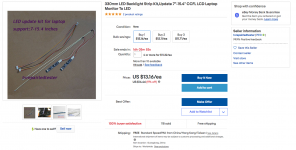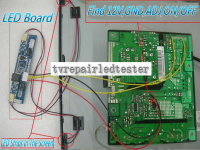davidg5678
Well-known member
Hello,
I have an iBook Clamshell with a screen that seems abnormally dim. I read that over time the CCFL backlights inside LCDs gradually dim as they wear out. I did a bit of poking about online and found some kits that seem to be able to replace the existing CCFL modules inside old displays with LEDs. There is very limited information available online, but from what I can tell, many of the kits come with a replacement LED driver board that is meant to be swapped into the place where the CCFL inverter used to be.
Here is an example eBay link for such a kit: https://www.ebay.com/itm/330mm-LED-Backlight-Strip-Kit-Update-7-15-4-CCFL-LCD-Laptop-Monitor-To-LED/272344643312?_trkparms=aid%3D111001%26algo%3DREC.SEED%26ao%3D1%26asc%3D225074%26meid%3D752983322adc45d69af056eee7011a72%26pid%3D100675%26rk%3D1%26rkt%3D15%26mehot%3Dnone%26sd%3D184476698668%26itm%3D272344643312%26pmt%3D1%26noa%3D1%26pg%3D2380057&_trksid=p2380057.c100675.m4236&_trkparms=pageci%3A26a49814-0c9a-11eb-bf7a-fa409d50a267|parentrq%3A1d49ceba1750ad32d24867c4ffedd7c6|iid%3A1
I have included a screenshot as well, for I am sure the link will eventually die (due to the temporary nature of eBay).
I am curious to hear other people's thoughts on these LED kits. Do you think it is worth trying to replace the CCFL lights inside my laptop? Could this same technology be refitted into a power-hungry 30" Cinema Display to make it run cooler while using less electricity?
(As a side note, I just realized the title of this post has a ridiculous number of acronyms in it. I'm sure most people here know the meanings of these acronyms, but I'll define them anyway.)
CCFL: Cold Cathode Fluorescent Lamp
LCD: Liquid Crystal Display
LED: Light Emitting Diode

I have an iBook Clamshell with a screen that seems abnormally dim. I read that over time the CCFL backlights inside LCDs gradually dim as they wear out. I did a bit of poking about online and found some kits that seem to be able to replace the existing CCFL modules inside old displays with LEDs. There is very limited information available online, but from what I can tell, many of the kits come with a replacement LED driver board that is meant to be swapped into the place where the CCFL inverter used to be.
Here is an example eBay link for such a kit: https://www.ebay.com/itm/330mm-LED-Backlight-Strip-Kit-Update-7-15-4-CCFL-LCD-Laptop-Monitor-To-LED/272344643312?_trkparms=aid%3D111001%26algo%3DREC.SEED%26ao%3D1%26asc%3D225074%26meid%3D752983322adc45d69af056eee7011a72%26pid%3D100675%26rk%3D1%26rkt%3D15%26mehot%3Dnone%26sd%3D184476698668%26itm%3D272344643312%26pmt%3D1%26noa%3D1%26pg%3D2380057&_trksid=p2380057.c100675.m4236&_trkparms=pageci%3A26a49814-0c9a-11eb-bf7a-fa409d50a267|parentrq%3A1d49ceba1750ad32d24867c4ffedd7c6|iid%3A1
I have included a screenshot as well, for I am sure the link will eventually die (due to the temporary nature of eBay).
I am curious to hear other people's thoughts on these LED kits. Do you think it is worth trying to replace the CCFL lights inside my laptop? Could this same technology be refitted into a power-hungry 30" Cinema Display to make it run cooler while using less electricity?
(As a side note, I just realized the title of this post has a ridiculous number of acronyms in it. I'm sure most people here know the meanings of these acronyms, but I'll define them anyway.)
CCFL: Cold Cathode Fluorescent Lamp
LCD: Liquid Crystal Display
LED: Light Emitting Diode



